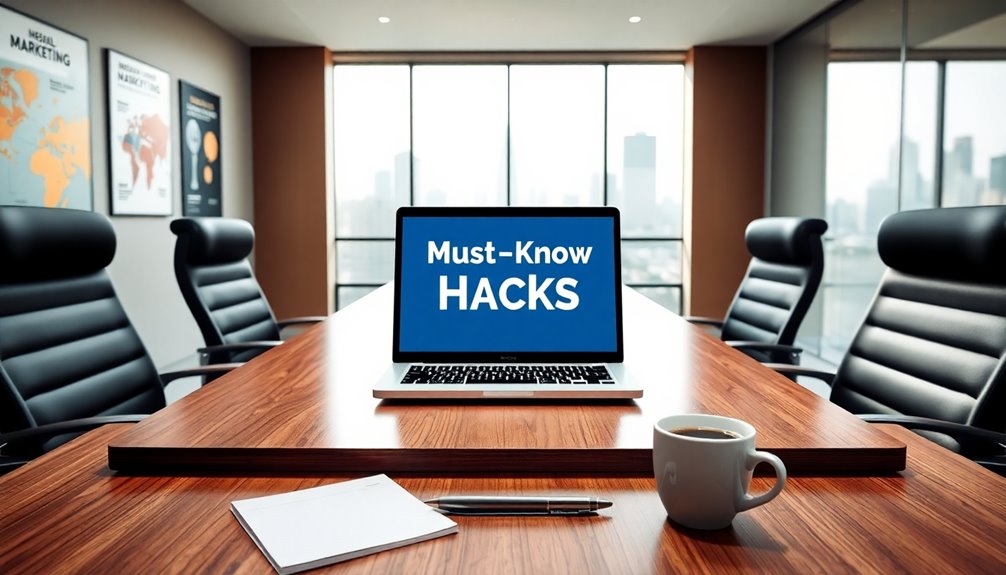To master the STAR technique, start by understanding its components: Situation, Task, Action, and Result. You'll need to clearly define the context of your challenge, your specific responsibility, the steps you took, and the outcomes. Identify relevant experiences that showcase your skills, and practice articulating these anecdotes aloud. This method not only enhances your storytelling but also boosts your confidence. Familiarize yourself with common behavioral questions and take a moment to gather your thoughts during interviews. With these strategies, you'll present compelling responses that leave a lasting impression. There's much more to explore to refine your interview skills.
Key Takeaways
- Understand the STAR method by breaking it down into Situation, Task, Action, and Result for structured responses.
- Prepare by reviewing the job description and identifying experiences that align with key skills required.
- Document specific situations that highlight your contributions and formulate responses focusing on your actions and results.
- Practice delivering your STAR responses aloud to enhance clarity and boost confidence during the interview.
- Use relaxation techniques, like deep breathing, to manage interview pressure and articulate your thoughts clearly.
Understanding the STAR Method

Often, interviewers rely on the STAR method to evaluate candidates' experiences and skills effectively. This structured approach helps you respond to behavioral questions by breaking down your answers into four key components: Situation, Task, Action, and Result.
By using this method, you can showcase specific examples that highlight your abilities and fit for the job. It encourages you to share real-life scenarios, making your responses not only clear but also memorable. This approach also allows you to provide evidence of your skills and experiences, rather than just listing them on your resume. Additionally, it gives you the opportunity to tailor your examples to align with the requirements of the position. By incorporating elevator pitch techniques into your responses, you can effectively communicate your value proposition and leave a lasting impression on the interviewer.
The STAR method enhances your storytelling, allowing you to demonstrate how you've tackled challenges and achieved results. Ultimately, mastering this technique can improve your communication and boost your confidence during interviews, giving you a competitive edge in the hiring process.
Key Components Explained

Understanding the STAR method lays the groundwork for effectively responding to interview questions.
By breaking your responses into four key components, you can present your experiences clearly and convincingly.
Here's a quick breakdown of each element:
- Situation: Briefly describe the context of the challenge you faced.
- Task: Highlight your specific responsibility or goal in that situation.
- Action: Focus on the steps you took to address the challenge, using "I" to emphasize your contributions.
- Result: Share the outcomes and what you learned from the experience.
Steps to Prepare Responses

To effectively prepare your STAR responses, start by reviewing the job description and identifying the key skills and challenges relevant to the role.
Next, think about experiences that showcase these strengths. Document specific situations where you faced challenges, emphasizing your contributions.
Focus on formulating responses that highlight your actions and the results achieved. Practice articulating these responses aloud to guarantee clarity and confidence.
It's also helpful to contemplate examples from internships, volunteer work, or personal challenges that align with the skills required.
Common Interview Questions

When preparing for interviews, it's essential to anticipate common behavioral questions that employers often ask. Familiarizing yourself with these questions can greatly boost your confidence and effectiveness during the interview.
Here are some typical questions you might encounter:
- Describe a difficult problem you faced at work and how you solved it.
- Share an experience where you made an unpopular decision and the outcome.
- Explain how you handled a high-pressure situation.
- Discuss a mistake you made and what you learned from it.
Effective Response Examples

Frequently, interviewers seek specific examples to gauge your problem-solving abilities and adaptability. For instance, when asked about a difficult problem, you might recount a time you faced a dress mix-up in retail.
Explain how you quickly ordered replacements and offered a gift card to upset customers, showcasing your initiative and customer service skills.
When discussing an unpopular decision, share how you managed a team reorganization for efficiency. Emphasize your transparent communication to ease concerns.
For mistakes, detail how you admitted an error in a project, implemented corrective measures, and learned from the experience. These structured responses, using the STAR method, clearly demonstrate your capabilities and leave a lasting impression on your interviewer. Additionally, reflecting on past mistakes can enhance your personal growth and resilience, making you a stronger candidate in future opportunities.
Handling Pressure in Interviews

During an interview, handling pressure effectively can be the key to showcasing your true potential. When faced with challenging questions or unexpected scenarios, staying calm and collected allows you to articulate your thoughts clearly.
Here are some tips to manage pressure during your interview:
- Breathe deeply before answering to center yourself.
- Take a moment to gather your thoughts; it's okay to pause.
- Focus on your strengths and relevant experiences to boost confidence.
- Visualize success to reinforce a positive mindset.
Building Client Relationships

Strong client relationships are the backbone of any successful business. To build these connections, you need to demonstrate genuine dedication and reliability. Always follow through on promises and communicate transparently, especially during challenging situations.
When clients see you handle pressure with professionalism, it fosters trust and encourages long-term partnerships.
Be proactive in resolving issues; a quick and effective solution can turn potential dissatisfaction into loyalty. Take the time to understand your clients' needs and preferences, and tailor your approach accordingly.
Enhancing Communication Skills

Effective communication serves as the cornerstone of successful client relationships and professional interactions.
By honing your communication skills, you can better articulate your thoughts and foster meaningful connections.
Here are some key strategies to enhance your communication:
- Listen actively: Pay attention to what others are saying to respond appropriately.
- Be clear and concise: Express your ideas directly to avoid misunderstandings.
- Adjust your tone: Tailor your language and delivery based on your audience.
- Practice non-verbal cues: Use body language and eye contact to reinforce your message.
Moreover, understanding the importance of emotional alignment can significantly improve your interactions in both personal and professional settings.
Frequently Asked Questions
How Can I Adapt STAR for Virtual Interviews?
To adapt STAR for virtual interviews, you'll want to focus on clear, concise communication.
Look at your background and choose relevant examples that fit the job. Practice your responses to guarantee you highlight your Situation, Task, Action, and Result smoothly.
Make eye contact with the camera, use body language to engage, and minimize distractions in your environment.
This approach keeps your responses memorable and impactful, even through a screen.
What if I Lack Relevant Work Experience for STAR Examples?
If you lack relevant work experience for STAR examples, don't worry! You can draw from internships, volunteer activities, or even personal projects.
Think about challenges you've faced in these situations. Focus on your actions and the results you achieved.
Highlight transferable skills, like teamwork or problem-solving, that apply to the job.
Practicing your responses will help you articulate your experiences confidently and show how you're a great fit for the role.
Can STAR Responses Be Used for Non-Behavioral Questions?
You can definitely adapt STAR responses for non-behavioral questions.
While STAR is primarily designed for behavioral scenarios, the structured approach can help you articulate your thoughts clearly.
For instance, when asked about your strengths or goals, you can outline a Situation, describe your Task, share Actions you'd take, and discuss the desired Result.
This method enhances your storytelling, making your answers more engaging and memorable, even outside typical behavioral contexts.
How Long Should a STAR Response Typically Be?
When it comes to crafting your STAR response, less is often more. Ideally, you want to keep it between 1 to 2 minutes. This timeframe lets you hit all the key points without rambling.
Focus on being concise while still telling a compelling story. Remember, you're painting a picture of your experience, so make your words count.
Strike a balance between detail and brevity, ensuring clarity and engagement throughout.
What if My Result Is Not as Expected?
If your result isn't what you expected, don't panic. Focus on the actions you took and what you learned from the experience.
Highlight how you adapted to challenges and any positive outcomes that arose despite the setback. This shows resilience and a growth mindset, which employers value.
Reflecting on the situation can demonstrate your ability to analyze and improve, making your overall experience more impactful in future discussions.
Conclusion
Incorporating the STAR technique into your interview preparation can greatly boost your chances of landing the job. Did you know that 70% of employers use behavioral questions to assess candidates? By mastering this method, you not only showcase your experiences effectively but also demonstrate your problem-solving skills and adaptability. So, as you gear up for your next interview, remember that a compelling story can make all the difference. Get ready to stand out and impress!
Eugene brings a fresh, dynamic voice to our platform as one of our talented Writers. Specializing in research-driven content, he explores the latest findings in psychology and personal growth, translating them into actionable insights for our readers. Eugene’s work is fueled by a curiosity about what makes us tick and a desire to help others unlock their potential.










